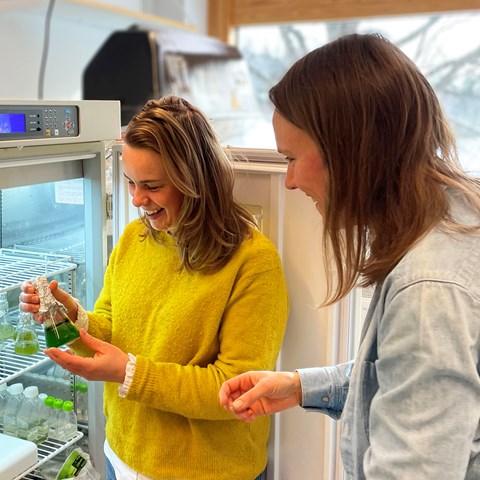Contact
Department of Aquatic Sciences and Assessment, Division of Microbial Ecology
Department of Aquatic Resources

We can expect toxic algal blooms to become more common as the climate changes. A better understanding of which toxins algae produce and under what circumstances this happens will therefore become increasingly important. To meet these challenges, we are launching a competence center for algal toxin analysis and the biology of toxic algae.
The competence center is a collaborative project between the Swedish University of agricultural sciences (SLU), the Swedish Meteorological and Hydrological Institute (SMHI), and the Swedish Food Agency, with the goal of gathering insights about toxic algal blooms, impacts on water quality and our aquatic resources. We will address questions such as when and where the toxins are produced, and what specific toxins are produced by different species and populations. Within the center we will also develop efficient routines for sampling and analysis of toxins, with the aim of investigating the prospects of including algal toxin analyses in regular water quality monitoring.
By collecting samples from many different water environments on a large scale, we will uncover general processes that apply to many different types of algal blooms. There is, at present, no national resource for the analysis of toxic algae in Sweden. The current lack of knowledge is also in part due to the fact that most studies have focused on a single type of environment.
- With the competence center, we will for the first time piece together many different factors to understand what is happening in our ecosystems, says Malin Olofsson. In the future, we want to be a broadly used and relevant resource both for environmental monitoring and for the broader research community.
Malin, a researcher at the Department of Aquatic Sciences and Assessment, will together with Elin Dahlgren at the Department of Aquatic Resources lead the establishment of the competence center. Three more SLU researchers with complementary skills will participate in the project (Stefan Bertilsson, Stina Drakare, and Karin Wiberg). By bringing together different organisations, it is possible to cover more perspectives and different types of analyses and areas of application. Aida Zuberovic Muratovic (Swedish Food Agency) contributes with experience in complex toxic analyses, and Bengt Karlson and colleagues at SMHI provide expert knowledge on harmful algae and collection of samples from SMHI's extensive environmental monitoring in the Baltic Sea. SMHI is the national data host for marine environmental monitoring data, and data regarding the occurrence of algal toxins will be added to the national database. In addition, SMHI is a partner in a large research project which deals with finding warning signals for harmful algal blooms with a focus on the use of seawater as drinking water on Gotland. This project (ALGOTL, run by Stockholms universitet) will contribute to the collection of samples for new studies within the framework of the knowledge center.
Previous studies indicate that the effects of ongoing climate change will lead to an increased frequency of blooms. This is especially true when combined with the lingering influence of eutrophication, as some species are synergistically stimulated by eutrophication and warming. This becomes particularly clear in the Baltic Sea, where the effects of eutrophication are still noticeable.
- There is a risk that these two factors will affect both occurrence and spread so that the blooms become more frequent and that the algae produce more toxins, says Malin. Therefore, this feels particularly relevant now and we hope to be up and running by early summer.
The knowledge center will focus on algal blooms in the Baltic Sea but also include the North Sea and inland waters. In the Baltic Sea, it is mainly summer blooms that cause problems and these are caused by a group of organisms called cyanobacteria. As the name suggests, this group of organisms is not algae but bacteria but is still usually grouped under the broader concept of algal blooms. The cyanobacteria can form very dense mats that create problems, such as reduced light for animals and plants below and oxygen is used up when they are decomposed, which can increase the spread of oxygen-free bottom waters. Several of them also produce chemical compounds that have toxic properties with partly unknown effects on their surroundings.
The knowledge center will start in the spring, with the hope of starting some pilot studies already in the summer. The operation is financed by the EU via the Swedish Agency for Agriculture for the next three years. The competence center will hopefully lay a foundation for continued environmental monitoring of toxic algal blooms in Swedish waters.
Dahlgren E, et al. (2022). A screening study of relationships among concentrations of algal toxins, PFAS, thiamine deficiency and biomarkers in the European flounder from the southern Baltic Sea. Reg Studies in Mar Sci 53:102427.
Karlson, B. et al. (2021). Harmful algal blooms and their effects in coastal seas of Northern Europe, Harmful Algae, Volume 102, 101989.
Olofsson, M. et al. (2020). Basin-specific changes in filamentous cyanobacteria community composition across four decades in the Baltic Sea,
Harmful Algae, 91, 101685.
Patria FP, Pekar H, Zuberovic-Muratovic A. (2020). Multi-Toxin Quantitative Analysis of Paralytic Shellfish Toxins and Tetrodotoxins in Bivalve Mollusks with Ultra-Performance Hydrophilic Interaction LC-MS/MS-An In-House Validation Study. Toxins (Basel), 12(7):452.
Pekar H, Westerberg E, Bruno O, Lääne A, Persson KM, Sundström LF, Thim AM. (2016). Fast, rugged and sensitive ultra high pressure liquid chromatography tandem mass spectrometry method for analysis of cyanotoxins in raw water and drinking water--First findings of anatoxins, cylindrospermopsins and microcystin variants in Swedish source waters and infiltration ponds. J Chromatogr A.,1429:265-76.